
Wenbo Yu
Dr. Wenbo Yu develops and uses computational methods to study the conformation changes, thermodynamic properties and interaction profiles of protein-protein interactions and complexes of proteins with small molecules. Dr. Yu focuses on development and application of computer-aided drug design (CADD) approaches for drug discovery, especially for cancer-related targets. In particular, he pursues new CADD methods development and coding; force field development; and molecular level simulation to investigate phenomena of biological and medicinal interest. In collaboration with experimentalists, Dr. Yu is studying new therapeutic targets, improving drug performance, and exploring structural level behaviors of drugs and macromolecules.

CURRENT RESEARCH
Computer-aided drug design (CADD) approaches are powerful tools that can complement experimental methods to expedite the process of drug discovery. For a new, experimentally identified target, a CADD approach can quickly screen millions of compounds that are available from commercial vendors. Using a sophisticated CADD technique can help to enhance the true positive rate and suggest a list of compounds for testing. Once hit compounds are identified, the CADD approach can be used to optimize lead compounds and improve binding affinities.

Using advanced CADD tools, Dr. Yu participates in a wide range of collaborative ongoing research projects within the Center of Biomolecular Therapeutics (CBT) to search for small molecule binders, optimize existing lead compounds, and explain their dynamic behaviors in targeting cancer, bacterial infections, and other diseases.
In addition to applying existing CADD approaches, Dr. Yu also develops new CADD methods validated through iterative coding and testing. He developed a new pharmacophore-based CADD approach to facilitate virtual screening of drugs for new targets. The new method builds pharmacophore models using energetic information from molecular dynamics simulations, rather than from static binding orientations of ligands. It also incorporates more information about conformational flexibility and the desolvation effect at the target binding pockets, which may benefit the virtual screening results. He is currently working on the development of a new protein-protein interaction (PPI) method for more accurate and robust predictions. Unlike existing methods, which are based on empirical functions, the new method is based on a new scoring function deduced from molecular dynamics simulations and is expected to provide a more accurate physical representation of PPI.
Dr. Yu is also working on structure-function studies of proteins and nucleic acids. He recently used molecular dynamics simulations to explain histone 3 (H3) methyltransferase NSD2 mutation effects on interactions of NSD2 with DNA/H3 complexes (both H3.3 and H3.1 variants). Understanding these interactions may provide new avenues for therapeutic interventions in NSD2 dysregulated malignancies, including relapsing acute lymphocytic leukemia (ALL), the most common pediatric cancer in the US.
Publications
- Computational Modeling of PROTAC Ternary Complexes as Ensembles Using SILCS-xTAC.
- Bile Acids Are Potential Negative Allosteric Modulators of M1 Muscarinic Receptors.
- GaSal-2: A Water-Soluble Antipseudomonal Agent Targeting the Extracellular Hemophore HasAp.
- High-Throughput Ligand Dissociation Kinetics Predictions Using Site Identification by Ligand Competitive Saturation.
- Potent and Selective Human Constitutive Androstane Receptor Activator DL5055 Facilitates Cyclophosphamide-Based Chemotherapies.
- Increasing the Accuracy and Robustness of the CHARMM General Force Field with an Expanded Training Set.
- Computationally Efficient Polarizable MD Simulations: A Simple Water Model for the Classical Drude Oscillator Polarizable Force Field.
- Detection of Putative Ligand Dissociation Pathways in Proteins Using Site-Identification by Ligand Competitive Saturation.
- Modeling Ligand Binding Site Water Networks with Site Identification by Ligand Competitive Saturation: Impact on Ligand Binding Orientations and Relative Binding Affinities.
- Toripalimab Plus Chemotherapy as a First-Line Therapy for Extensive-Stage Small Cell Lung Cancer: The Phase 3 EXTENTORCH Randomized Clinical Trial.
- Revised 4-Point Water Model for the Classical Drude Oscillator Polarizable Force Field: SWM4-HLJ.
- Enhancing SILCS-MC via GPU Acceleration and Ligand Conformational Optimization with Genetic and Parallel Tempering Algorithms.
- Perioperative Toripalimab Plus Chemotherapy for Patients With Resectable Non-Small Cell Lung Cancer: The Neotorch Randomized Clinical Trial.
- Dendritic Cell-Mediated Cross-Priming by a Bispecific Neutralizing Antibody Boosts Cytotoxic T Cell Responses and Protects Mice against SARS-CoV-2.
- Integrated Covalent Drug Design Workflow Using Site Identification by Ligand Competitive Saturation.
- Structure-Based Design of Potent Iminosugar Inhibitors of Endoplasmic Reticulum α-Glucosidase I with Anti-SARS-CoV-2 Activity.
- hERG Blockade Prediction by Combining Site Identification by Ligand Competitive Saturation and Physicochemical Properties.
- Computer-Aided Drug Design: An Update.
- Scaffold hopping from indoles to indazoles yields dual MCL-1/BCL-2 inhibitors from MCL-1 selective leads.
- Cholecalciferol complexation with hydroxypropyl-β-cyclodextrin (HPBCD) and its molecular dynamics simulation.
- Application of Site-Identification by Ligand Competitive Saturation in Computer-Aided Drug Design.
- Development of CHARMM Additive Potential Energy Parameters for α-Methyl Amino Acids.
- Rapid and accurate estimation of protein-ligand relative binding affinities using site-identification by ligand competitive saturation.
- Profiling the Tox21 Chemical Collection for Acetylcholinesterase Inhibition.
- Specificity of Molecular Fragments Binding to S100B versus S100A1 as Identified by NMR and Site Identification by Ligand Competitive Saturation (SILCS).
- Discovery of beta-lactamase CMY-10 inhibitors for combination therapy against multi-drug resistant Enterobacteriaceae.
- Small molecules inhibitors of the heterogeneous ribonuclear protein A18 (hnRNP A18): a regulator of protein translation and an immune checkpoint.
- The SKI complex is a broad-spectrum, host-directed antiviral drug target for coronaviruses, influenza, and filoviruses.
- Impact of electronic polarizability on protein-functional group interactions.
- Optimization of a Benzothiazole Indolene Scaffold Targeting Bacterial Cell Wall Assembly.
- Identification and characterization of fragment binding sites for allosteric ligand design using the site identification by ligand competitive saturation hotspots approach (SILCS-Hotspots).
- Structure of the cell-binding component of the Clostridium difficile binary toxin reveals a di-heptamer macromolecular assembly.
- Exploring protein-protein interactions using the site-identification by ligand competitive saturation methodology.
- An activating mutation of the NSD2 histone methyltransferase drives oncogenic reprogramming in acute lymphocytic leukemia.
- Identification of Thiourea-Based Inhibitors of the B-Cell Lymphoma 6 BTB Domain via NMR-Based Fragment Screening and Computer-Aided Drug Design.
- Structure-based design and biological evaluation of inhibitors of the pseudomonas aeruginosa heme oxygenase (pa-HemO).
- The Expanding Role of the BCL6 Oncoprotein as a Cancer Therapeutic Target.
- Computer-Aided Drug Design Methods.
- Estimating glycosaminoglycan-protein interaction affinity: water dominates the specific antithrombin-heparin interaction.
- Rationally designed BCL6 inhibitors target activated B cell diffuse large B cell lymphoma.
- Iminoguanidines as Allosteric Inhibitors of the Iron-Regulated Heme Oxygenase (HemO) of Pseudomonas aeruginosa.
- Novel protein-inhibitor interactions in site 3 of Ca(2+)-bound S100B as discovered by X-ray crystallography.
- Structure-based design of N-substituted 1-hydroxy-4-sulfamoyl-2-naphthoates as selective inhibitors of the Mcl-1 oncoprotein.
- Facile Synthesis of Spirocyclic Lactams from β-Keto Carboxylic Acids.
- Structure-activity exploration of a small-molecule Lipid II inhibitor.
- Mapping functional group free energy patterns at protein occluded sites: nuclear receptors and G-protein coupled receptors.
- Pharmacophore modeling using site-identification by ligand competitive saturation (SILCS) with multiple probe molecules.
- Inclusion of multiple fragment types in the site identification by ligand competitive saturation (SILCS) approach.
- Turning defense into offense: defensin mimetics as novel antibiotics targeting lipid II.
- The novel BH3 α-helix mimetic JY-1-106 induces apoptosis in a subset of cancer cells (lung cancer, colon cancer and mesothelioma) by disrupting Bcl-xL and Mcl-1 protein-protein interactions with Bak.
- Six-site polarizable model of water based on the classical Drude oscillator.
